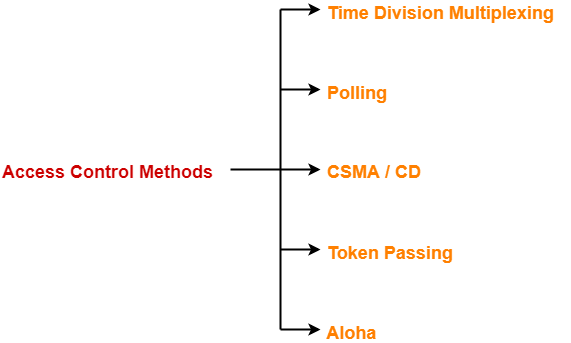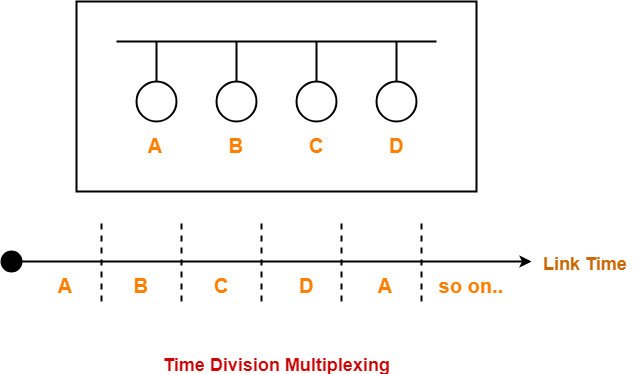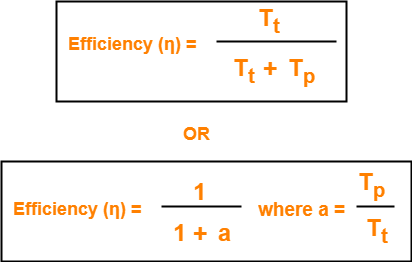Access Control in Networking-
Before you go through this article, make sure that you have gone through the previous article on Access Control.
We have discussed-
- Access Control is a mechanism that controls the access of stations to the transmission link.
- Broadcast links require the access control mechanism.
- There are various access control methods-

In this article, we will discuss about Time Division Multiplexing (TDM).
Time Division Multiplexing-
In Time Division Multiplexing (TDM),
- Time of the link is divided into fixed size intervals called as time slots or time slices.
- Time slots are allocated to the stations in Round Robin manner.
- Each station transmit its data during the time slot allocated to it.
- In case, station does not have any data to send, its time slot goes waste.
Example-

Size Of Time Slots-
The size of each time slot is kept such that each station gets sufficient time for the following tasks-
- To put its data packet on to the transmission link
- Last bit of the packet is able to get out of the transmission link
Thus,
| Size of each time slot = Tt + Tp |
where-
- Tt = Transmission delay
- Tp = Propagation delay
NOTE-
To keep the size of time slots constant,
- We have assumed that all the stations want to send the packets of same size.
- This keeps Tt constant for all the stations.
- We have considered the worst case when both the stations are present at the two extreme ends.
- This ensures Tp will be maximum and all the stations will get sufficient time to propagate their data.
Efficiency-
| Efficiency (η) = Useful Time / Total Time |
- Useful time = Transmission delay of data packet = Tt
- Useless time = Propagation delay of data packet = Tp
Thus,

Important Formulas-
- Size of each time slot in Time Division Multiplexing = Tt + Tp
- Efficiency (η) = 1 / (1+a) where a = Tp / Tt
- Effective Bandwidth / Bandwidth Utilization / Throughput = Efficiency(η) x Bandwidth
- Maximum Available Effective Bandwidth = Total number of stations x Bandwidth requirement of 1 station
Disadvantage-
- If any station does not have the data to send during its time slot, then its time slot goes waste.
- This reduces the efficiency.
- This time slot could have been allotted to some other station willing to send data.
PRACTICE PROBLEM BASED ON TIME DIVISION MULTIPLEXING (TDM)-
Problem-
If transmission delay and propagation delay of a packet in Time Division Multiplexing is 1 msec each at 4 Mbps bandwidth, then-
- Find the efficiency.
- Find the effective bandwidth.
- How many maximum stations can be connected to the network if each station requires 2 Kbps bandwidth?
Solution-
Given-
- Transmission delay (Tt) = 1msec
- Propagation delay (Tp) = 1msec
- Bandwidth = 4 Mbps
Part-01:
For a TDM Network,
| Efficiency (η) = 1 / 1+a where a = Tp / Tt |
Calculating Value Of ‘a’-
a = Tp / Tt
a = 1 msec / 1 msec
a = 1
Calculating Efficiency-
Efficiency (η)
= 1 / (1+a)
= 1 / (1 + 1)
= 1 / 2
= 0.5
= 50%
Part-02:
We know-
| Effective Bandwidth = Efficiency (η) x Bandwidth |
Thus,
Effective Bandwidth
= 0.5 x 4 Mbps
= 2 Mbps
Part-03:
We know-
| Maximum Effective Bandwidth
= Total number of stations x Bandwidth requirement of 1 station |
Let the total number of stations that can be connected be N.
Then, we have-
2 Mbps = N x 2 Kbps
N = 1000
Thus, maximum 1000 stations can be connected.
To gain better understanding about Time Division Multiplexing (TDM),
Next Article- Polling | Access Control Method
Get more notes and other study material of Computer Networks.
Watch video lectures by visiting our YouTube channel LearnVidFun.

